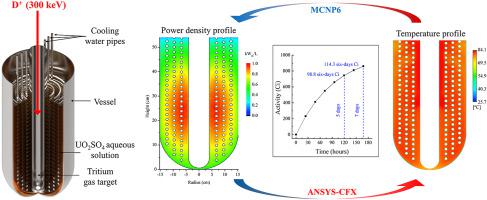Progress in Nuclear Energy ( IF 2.7 ) Pub Date : 2021-02-26 , DOI: 10.1016/j.pnucene.2021.103692 Liván Hernández Pardo , Daylen Milian Pérez , Daniel Milian Pérez , Daniel E. Milian Lorenzo , Carlos A. Brayner de Oliveira Lira

|
The most common medical isotope (99mTc) is widely used for the diagnosis and therapy of complex diseases, with approximately 30–40 million nuclear medicine procedures worldwide every year. Although 99mTc can be directly produced in particle accelerators, it is generally obtained from the beta-decay of 99Mo. The utilization of an accelerator-driven Aqueous Homogeneous Subcritical System to produce 99Mo has several advantages and therefore, represents an attractive alternative to the conventional method of irradiating uranium solid targets in nuclear research reactors. This paper aims to perform a multi-physics evaluation of an Aqueous Homogeneous Subcritical System conceptual design with low enriched uranium (LEU), driven by a D-T neutron generator, to produce 99Mo in safe conditions. A coupled iterative calculation methodology was implemented to predict the steady state operation of the system at 20 kWth using the MCNP6 and ANSYS-CFX 18.1 codes for neutronic and thermal-hydraulic calculations, respectively. The main neutronic and thermal-hydraulic parameters were monitored to verify if they met the established convergence criterion of 1% to stop the calculation process. The methodology convergence was reached after four calculation steps when the most changing parameter, average fuel solution velocity, satisfied the criterion. However, others such as the average bubble velocity, the ion beam current, the fuel solution height and the effective multiplication factor varied less than 0.1% in the fourth step. A burnup calculation has shown that the system is capable of producing 114.3 six-days Ci of 99Mo in a one-week operation period and significant amounts 133Xe, 131I and 89Sr.
中文翻译:

耦合多物理场模拟,用于评估加速器驱动的医学同位素生产的水均相亚临界系统
最常见的医学同位素(99m Tc)被广泛用于复杂疾病的诊断和治疗,全世界每年约有30–40百万个核医学程序。虽然99米锝可以在粒子加速器可以直接产生,所以一般从的β-衰变得到99的加速器驱动水性齐次临界系统的Mo中的至少利用以产生99Mo具有几个优点,因此是在核研究反应堆中辐照铀固体靶材的常规方法的一种有吸引力的替代方法。本文旨在对由DT中子发生器驱动的低浓铀(LEU)的水均质亚临界系统概念设计进行多物理场评估,以在安全条件下产生99Mo。实施了耦合迭代计算方法以预测系统在20 kW th时的稳态运行使用MCNP6和ANSYS-CFX 18.1代码分别进行中子和热工液压计算。监视主要中子和热工液压参数,以验证它们是否满足已建立的1%收敛准则,以停止计算过程。当变化最大的参数(平均燃料溶液速度)满足标准时,经过四个计算步骤,方法学趋于一致。但是,在第四步中,平均气泡速度,离子束电流,燃料溶液高度和有效倍增系数等其他变量的变化小于0.1%。燃耗计算表明,该系统能够在一周的运行时间内产生114.3的99天Mo的六天Ci,且显着量为133 Xe,131我和89高级


























 京公网安备 11010802027423号
京公网安备 11010802027423号